
views
Blocking High Punches (Age Uke)
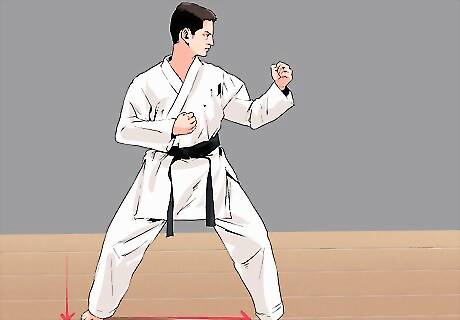
Assume the proper defensive stance. Spread your feet slightly wider than shoulder-width apart. Lower your center of gravity between your legs with the knees bent and the body stable and unmoving. Your weight should be positioned mainly on the balls of your feet. In age uke, the body can be facing the opponent head-on or may be angled slightly to present less of a target. Create a solid base, but stay light on your feet so that you can move at a moment’s notice.
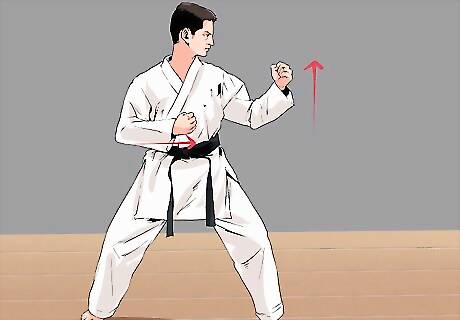
Have the arms poised and ready. To begin the blocking movement, your arms should be in a “chambered” position (fists clenched with fingers facing upward at either hip) or raised defensively in front of the body. This is to have them as close as possible to the anticipated strike in order to effectively protect the head and face. Your fists can be held open or closed, but do not clench them until the moment of impact. Clenching your fist creates unnecessary tension in the arms and shoulders, which can exhaust you and reduce your reactive speed.
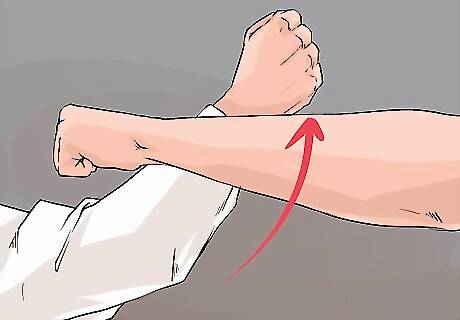
Raise the blocking arm to meet the strike. With the elbow bent at roughly 45 degrees, lift your blocking arm up and outwards in a tight arc until your forearm is held laterally over your forehead. As you begin the block, your forearm will catch your opponent’s strike and redirect their force safely over the top of your head or off to the side. This high blocking technique is known as age uke. Age uke will stop high punches to the head, as well as downward smashing strikes with the fist or a bludgeoning weapon. Whenever possible, meet your opponent’s striking arm with both large bones of the forearm rather than the edge. This is known as a “double bone block,” and is much more effective at shutting down attacks as well as preventing injury.
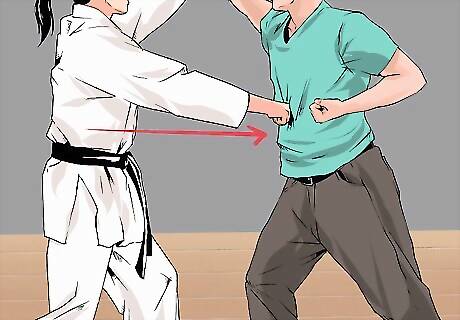
Initiate a counterattack. Now that your opponent’s strike has been deflected, their balance will be compromised and they will be open to a counter strike. Take advantage of the opportunity and strike back with a straight punch to the face or solar plexus. Both the block and the counterattack should be performed with quick, powerful motions, “snapping” the technique upon impact. Power in the counter punch should come from quick, twisting motion of the hips and shoulders, shooting the arm straight out like a piston. Make contact with the largest knuckles of the pointer and middle fingers to keep from hurting your hand. Your best target for counter attacking is based on your positioning in relation to your attacker. The head and body both make good targets when left exposed. You can also trap the attacker’s punching arm to apply a grappling technique. This will allow you to subdue them without having to hit them in return.
Blocking Punches to the Body (Soto Uke/Uchi Uke)

Adopt a stable defensive posture. Sink your weight between your knees to keep from being knocked off your center of balance. For blocking strikes directed at the body, you may take either naihanchi-dachi (with the legs wide and the body facing your opponent) or zenkutsu-dachi stance (with the legs staggered and your weight positioned over the front foot). Have your hands chambered or raised to protect the midsection. It is critical to take a wider stance when defending body attacks to prevent being forced off balance by a strike to the center of your mass. The lower you sink into your defensive stance, the harder you will be to move. You’ll also have a clearer shot at your opponent’s lower extremities such as the ribcage, solar plexus and groin.
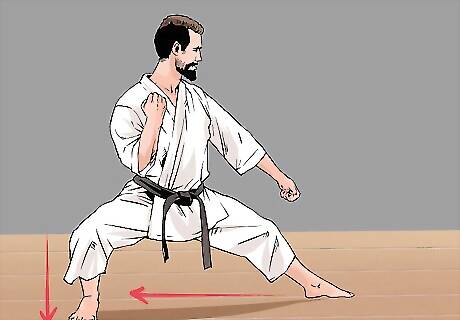
Turn your body away from the opponent slightly. Rather than accept the strike head-on, rotate your shoulders and hips so that one shoulder is pointing toward your opponent. Angling the body slightly creates a smaller target for the attacker to aim for, making you harder to hit. From this position, you can decide whether to employ an inward block (uchi uke) with the lead arm or an outward block (soto uke) with the rear arm. By turning your upper body slightly, you “close off” your body, keeping your torso more guarded, and present your shoulder to your attacker rather than your chin. From this position, punches delivered with the rear chambered hand will have the most power.
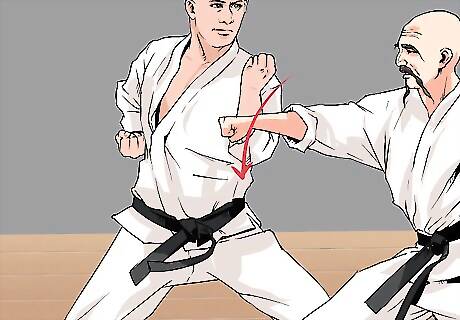
Bring the blocking arm up and inward from the hip (Soto Uke). With your fist clenched and your arm held firm, swing your blocking arm up and inward to deflect the punch. When delivering an outward block, your fingers should be facing you, and you will make contact with the inside of your forearm or elbow. Soto uke is defined as an “outward” block because the blocking arm begins its from outside the body’s center line and moves inward. Use soto uke to defend against jabs and straight punches. Outward blocks divert the attacker's arm to the inside of your guard. This leaves you in a position to use a counter punch, knee strike, arm lock or throw. Outward blocks are quite similar to a boxer's parry.
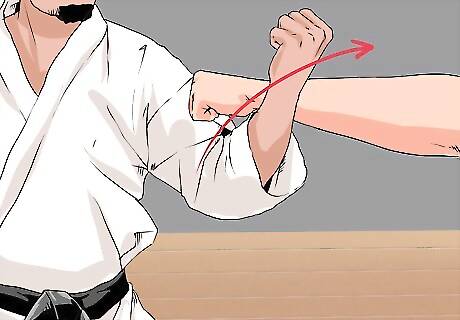
Turn the blocking arm up and outward from the hip (Uchi Uke). As an alternative to soto uke, you might be in a better position to employ uchi uke, or an inward block. From a chambered or defensive guard, raise and rotate your blocking arm outward from your opposite hip, catching the punch with the outside of your forearm. Inward blocks open up the center of your attacker’s body, allowing you to follow up with an unobstructed strike.

Counter the strike. Your attacker should now be in a vulnerable position with their arm fully extended and their face and body exposed. Continue diverting the punch with your forearm and return a strike of your own to the most sensitive target on your opponent’s body. The block and counter strike should be performed in quick succession as one fluid movement. Decide whether to strike to the ribs, midsection or face depending on the position of your opponent’s punching arm and the placement of your own body.
Blocking Low Punches (Gedan Barai)

Get into a staggered stance. Place the foot corresponding to your non-dominant hand in front of the other. For example, if you are right-handed, put your left foot forward. Let your feet find a natural and comfortable position; the best way to do this is to take a normal step, then pause and stabilize your weight. For blocking low strikes, it is generally easier to defend from a walking (shizentai-dachi) or cat stance (nekoashi-dachi), as this allows you to defend the lower body without the legs getting in the way of the block. Gedan barai can be employed from many different defensive stances, but stances with the legs staggered are the most natural as they put the body in a less clumsy position to protect the hips, groin and legs. In nekoashi-dachi (cat stance), the weight is poised mostly over the back foot, with the heel of the front foot raised to enable a quick transitional movement or kick. This positioning closely resembles a boxer’s fighting stance.

Raise the blocking arm to your opposite shoulder. Bring your blocking arm across your body until your fist is positioned beside your opposite ear. As you initiate the block, you will quickly reverse this motion, creating enough momentum to slow or stop the oncoming strike. In a downward block, the blocking arm should pass from the opposite shoulder down to the lead hip. Keep the fist close to the body and use the leverage of the hips and shoulders to stabilize the blocking arm.
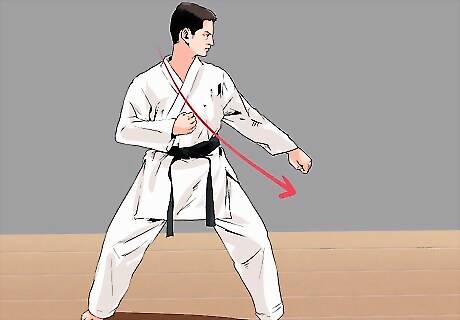
Bring the blocking arm downward to neutralize the attack. From your opposite shoulder, bring your blocking arm down and across your body forcefully to intercept the strike. Your fist should stop a few inches above your lead leg, forearm parallel with your thigh. Tense your arm and shoulder at the moment of impact to ensure that the strike doesn’t break through your defense. The purpose of the downward block is not so much to stop an attack outright, but to minimize its impact and do damage to the opponent’s attacking limb. Gedan barai is useful for breaking a grab and defending against uppercuts and hooks to the body.
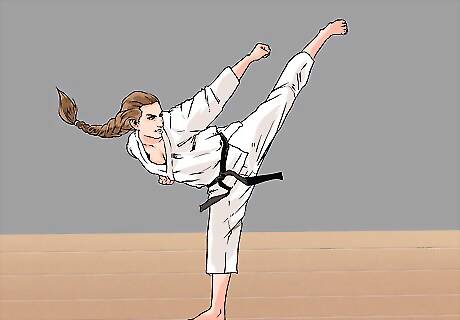
Strike back. Once the attack has been defended, launch a strike of your own to fend off or incapacitate your opponent. One benefit of a staggered stance is that it allows for greater diversity in your choice of counter attack. You can respond with a straight punch thrown from the hip, but will also be in a position to throw a kick or knee strike with the rear leg. Strike at an undefended point on your opponent’s body, and be prepared to defend against any other follow-up attacks. Though they are somewhat less stable than deeper defensive postures, cat stance and walking stance arguably offer a greater variety of offensive options.
















Comments
0 comment